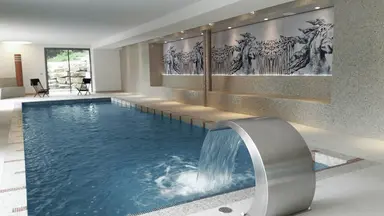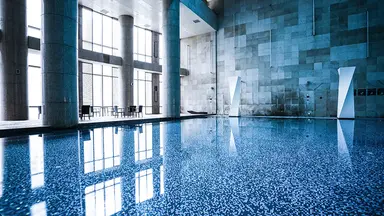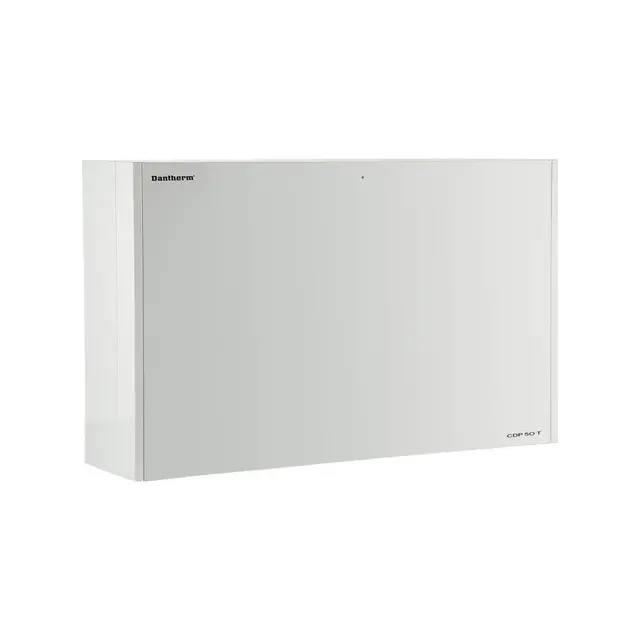Our essential guide to controlling the humidity of indoor pools

- Home
- Insights
- Humidity control and drying insights
- Our essential guide to controlling the humidity of indoor pools
Excessive humidity is one of the biggest threats to the long-term quality, safety and viability of swimming pools (and their surrounding structures), and far too many indoor pools have been eaten away over the years by the mould, bacteria, rot and corrosion this can cause.
There is no way to avoid evaporation in an indoor pool. It happens when people are splashing about in the water every day, or when laying back on loungers alongside it.
Depending on the size of the pool, evaporation could be adding thousands of litres of water into the atmosphere in a short period of time, making the surrounding air particularly humid. For example, a 46m² pool could be expected to lose around 355 litres of water per day simply as a result of evaporation
This leads us to the all-important question – “How do I control the humidity in my indoor pool?” In this article, we’ll deliver the answer.
The consequences of uncontrolled humidity in indoor pools
First, we feel it’s important to reiterate the potential implications for indoor swimming pools with no dehumidification solution in place, because unfortunately there are still people out there that don’t recognise how devastating this omission can be over time.
At the most fundamental level, the problems caused by excessive humidity inside pools fall into two categories:
Issues that affect the quality of the pool and surrounding building
Issues that affect pool users and others
When water vapour escapes the swimming pool, once it hits a suitably cold enough surface, be it the walls of the pool room, a window or the ceiling, it will condense on these areas. Over time, the consistent presence of water can seep into the building materials, causing them to develop mould, rust, bacteria and more, all of which can significantly hurt their structural strength.
This is further exacerbated by the presence of chlorine in the pool water. Chlorine’s corrosive properties will attack building materials even more aggressively than water on its own. Wood rots. Metal rusts. Mould breeds.
Consequently, you will need to devote more time and resources into maintaining and repairing the environment around your indoor pool, which can cause costs to skyrocket over time. It may also lead electrical equipment to malfunction, which again could carry heavy costs.
In relation to how high humidity affects people, it naturally creates uncomfortable, sweltering environments for those in the area, making them more likely to avoid the pool where possible.
Furthermore, the development of mould, mildew and bacteria may cause people to sustain allergic reactions, rashes, coughs and respiratory issues, again making their pool experience not only uncomfortable, but potentially hazardous for their health. Plus, if condensation forms on the floor around the pool, this could lead to slips and other accidents.
With these problems in mind that can endanger both the sustainability of the pool area and the wellbeing of those who use it day-to-day, it is essential that indoor pool owners have a dehumidification solution in place to avoid these problems long-term.
Understand the air, control the humidity
Air expands in warmer temperatures, and contracts when it cools. This means that, in warmer temperatures, the air can absorb more water vapour. Then, when it hits cooler surfaces and reaches the 'dew point', it will condense into water, where it can then do damage to the surrounding structures.
The dew point is a crucial term in relation to the dehumidification of indoor swimming pools. Humid air will condense on a cold surface when the temperature of the cold surface is below the dew point.
Another important term to keep in mind is the relative humidity (RH). This is the ratio of the current absolute humidity to the highest possible absolute humidity. So at 100% RH, the air is as saturated with water as it possibly can be in that environment.
Recommended RH levels for indoor swimming pools = 50-60%
Not overly humid to the point of becoming uncomfortable to swimmers
Not so dry as to cause water to evaporate too fast, making swimmers feel colder
Additional key considerations for complete humidity control include:
Keeping the room temperature approximately 2ºC higher than the pool water temperature – this limits the amount of water vapour entering the atmosphere
Ensuring the pool has a negative pressure vacuum – this means if a door is opened, cold air should rush into the room, rather than wet air escaping
Installing the correct pool dehumidifier is the key to ensuring that humidity levels stay within these suitable bounds. When appropriately chosen, these will maintain RH at an appropriate level, adjustable in relation to changes in temperature, number of occupants and other variables.
However, there is not a one-size-fits-all solution for all pool environments. Factors including the scale of your swimming pool, the volume of the room it’s contained in, and how populated you expect it to be will actively determine the size and capacity of the system you require. This will ensure the humidity doesn’t spiral out of control, but also that you don’t pay over the odds when there is a more cost-effective solution that’ll meet your needs.
Find the right dehumidifier for your indoor pool
If you have encountered any of the problems noted above and found yourself asking “How can I control the humidity in my indoor pool?”, then you’ll find the solution across Dantherm Group’s powerful range.
Our dehumidification systems actively protect against moisture damage, and are tailor-made to suit the requirements in any indoor pool. Whether you are seeking a solution for a compact indoor or hotel pool, or an Olympic-sized giant pool for public use, our flexible production process guarantees that your system is designed to fulfil your needs, while at the same time helping you secure maximum energy savings through effective heat recovery.
To learn more about how the Dantherm Group range can put you in complete control of the humidity surrounding your indoor pool, speak to our team today.
Related products
Featured insights

How a dehumidifier can help you create the perfect environment

5 important factors for determining the operating conditions of your pool

Gain valuable insight into what you need to select the right size dehumidifier for your pool.
Need help with choosing the right solution? Our team of over 100 climate control experts can assist.
You can also reach out or join the discussion on our Social Media. Check out our LinkedIn page.

